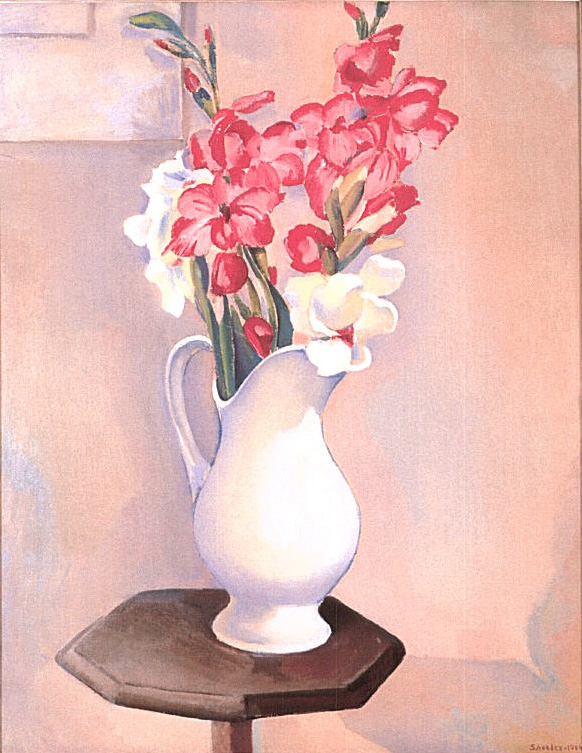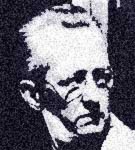
Charles Sheeler
American, 1883-1965
Gladioli in White Pitcher, 1926
oil on canvas
28 1/2 x 22 1/8 in.
SBMA, Gift of Wright S. Ludington
1944.2.14

Undated photo of Sheeler
"Photography is nature seen from the eyes outward, painting from the eyes inward. Photography records inalterably the single image while painting records a plurality of images willfully directed by the artist." - Charles Sheeler
RESEARCH PAPER
Charles Sheeler was born into a Philadelphia family of limited means, his father being an employee of a steamship company. By the time Charles had graduated from high school he was determined to be an artist. His family, however, directed him first into a three-year study of industrial design. Charles found it gloomy, and then enrolled in the Pennsylvania Academy of Fine Arts, where he came under the flamboyant tutelage of William Merritt Chase, who had trained in Munich, Germany. He taught Sheeler his principles of spontaneity of brush stroke and expression. However, after Sheeler had been to Europe himself several times, he discarded Chase’s advice and became convinced that design should supercede the importance of either brushwork or personal stylistic effects.
He became a commercial photographer of architectural and industrial subjects in 1912 and pioneered the "sharp focus" effects, in contrasts to the soft pictorial style of his contemporaries. He had been interested in photography for several years prior to this, and he had become interested in the new Cubism, which he began to transform in the direction of realism. Cubistic Realism became also known as "Precision". His photographic skill and outstanding draftsmanship recorded the American industrial landscape in a new kind of drama with a magical clarity of visual detail suggestive of the illusionistic Surrealism of Dali.
A close examination of Gladioli in a White Pitcher finds it explicitly representational, of course, but it does not seem consistent with an expectation of Charles Sheeler as the Precisionist.
Perhaps Sheeler was interested in the idealization of man-made forms of his industrial landscapes, but was rebelling against the artists who idealized nature’s irregularities too much. In this picture he treats the man-made pitcher the way he would depict a silo, for example, as an idealized geometric shape- well, almost, but not quite. (But why did he outline the contour so strongly in pencil, and then not fill in the white of the pitcher completely?) The flowers are nature’s, and are quite skillfully drawn, but especially the red gladioli are not rendered in a convincing texture that reveals the extremely thin, fragility of the petals. They form, instead, a two-dimensional pattern. The painting doesn’t give a clue to the material of which the pitcher is made.
In finding fault with precision, observe that the gesso ground applied to the canvas before Sheeler painted the subject is not evenly applied. In a number of spots the canvas shows through.
But Charles Sheeler was not a careless painter. He knew always exactly the effect he wanted to achieve, and he had a reason for everything he did. If the foregoing seem to be shortcomings, but were actually intentional, then we must assume he wanted viewers to examine closely. To do this he forced closer examination by placing the pitcher on the octagonal top of its stand completely off center. In this painting he has painted from only one point of view. In later years he forced viewer attention by painting a picture from more than one point of view at the same time.The composition of his subject forms two "V"s: the red flowers are contained within the V, formed when the two diagonals of the painting are drawn. The white flowers and the picture determine an elongated V, starting at the top of the left stalk, descending to the base of the pitcher, and rising through the pitcher to the top of the right stalk of the flowers.
The lighting seems almost surely to have been set up as if he was going to photograph the arrangement. At least three lights are indicated by the shadows cast on the wall behind. That it is a wall is established by the presence of a picture frame in the upper left-hand corner of the painting. There is no horizon line; and it is unclear how far back the wall is.The main light is a spotlight high to the left since it casts a spectral shadow on the wall at lower right. A second light is softer and comes from below and to the right; and finally, a very soft light just to the left of the artist fills in the strong shadows of the arrangement and casts a faint shadow of the arrangement to its right.
The palette used for the subject contains a strong red, plus tints to high light, clean white, some yellow and dark green. The background colors are tints of green, well distributed, as well as yellow, lavender and rose. Finally, the viewer should linger a moment to appreciate the beautiful music produced by the two kinds of curves in the painting: the sweeping curves of the pitcher’s contour that establish the musical theme: and the musical texture provided by the contours of the red and white flowers. Here, if nowhere else, one can sense the vital force that Charles Sheeler poured into this work.
Prepared for the SBMA Docent Council by W. R. Jennings, 1982
